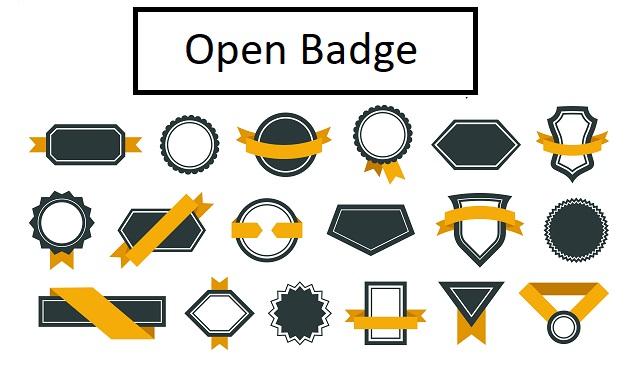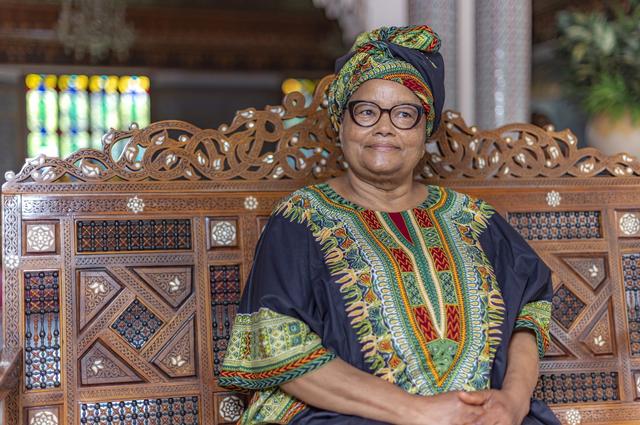Open badges and professional recognition
« Adieu diplômes, voici les badges ! » titre un article du Figaro Étudiant en 2012. De quoi s’agit-il et quel est donc le nouveau prétendant au remplacement de ces diplômes qui, depuis des décennies, suscitent en France tant de réactions ambivalentes, de la révérence à la détestation ? D’un point de vue technique, un Open Badge est une image numérique qui permet d’objectiver la reconnaissance d’un savoir, d’une compétence, d’un savoir-être, d’une expérience ou même d’une pratique.A certain number of information is recorded such as the identity of the badge receiver, that of the issuer, the criteria for allocation of the badge and the evidence justifying its allocation.Introduced by the Mozilla Foundation [1] in 2011, open badges were quick success.The stake, affirmed from the start by the Foundation, is to move the center of gravity of the power of the recognition of institutions to individuals, by contesting the quasi-monopoly of certifiers in the recognition of learning, especially when itIncrease in informal learning.
In a way, it is the logic of the peer to peer which penetrates the sphere of recognition, which arouses quite dizzying questions.In 2021, the history of badges is still in its early days and the great diversity of uses that are made to do so undoubtedly their boom, while aroused a certain perplexity on the prospects they offer.It is this perplexity that encourages us to take stock of this nascent movement, the forms he takes, the hopes and the questions he arouses.We will first try to put into perspective the movement of open badges in relation to the older experience of knowledge trees.We will then ask ourselves who are the actors of the open badges today and why the state is interested in the point of making them place as a relevant tool in the vocational training policy.We will finally use a critical map of the uses of open badges, proposed in a reflexive approach by one of its main promoters in France, in order to appreciate different effective uses of badges as to their interest, their limits and the risks theyraise.
Trees of knowledge to open badges
If they are part of the wake of the free community, the issue of recognition of informal learning to which open badges are trying to respond is well prior to digital development. Sans remonter trop loin dans le temps, on peut lire une parenté entre la démarche des « arbres de connaissance » élaborée au début des années 1990 et le mouvement actuel des open badges.
It is faced with the logic deemed excluded from the diploma that the idea of knowledge trees germinates, between November 1991 and February 1992, during the work of a mission entrusted to Michel Serres on the university of distance, whichThe two authors (Michel Authier and Pierre Lévy) were members. Josiane Teissier précise : cette idée « visait à une rupture centrale par rapport au diplôme comme norme sociale de la relation emploi-formation.It was a question of creating devices, by which the reality of the knowledge and know-how of each, whatever their mode of acquisition, can be visible. » [3]
The process of building a knowledge tree in theory three stages in theory.It is first of all a question of collectively defining the objective pursued by the use of a knowledge tree, of developing a charter of use and of enacting the rules of construction and allocation of patents.Then comes the construction phase during which is a first patent base from an initial group of people.The tree begins to take shape with the coats of arms (set of patents) of these first people involved.Then the approach can be opened to others who can in turn obtain coats of arms while respecting the decreased rules, but also file new patents if they consider that existing ones are not enough. Chaque membre du collectif dispose ainsi de plusieurs possibilités pour intervenir : il peut être partie prenante dans la définition du projet en co-construisant les règles du jeu ; il peut déposer des brevets nouveaux, ce qui suppose un véritable travail d’analyse, tout en s’inscrivant dans les règles communes ; il peut simplement s’attribuer des brevets, dans le respect des procédures et critères qui ont été définis par le groupe.
Comme le constate Josiane Teissier, « paradoxalement, ce ne sont pas les experts du bilan qui ont d’abord expérimenté mais plutôt les organismes de formation et d’insertion professionnelle pour les publics dits en difficulté, en référence fréquente aux "histoires de vie" (Gaston Pinaud) et "portefeuilles de compétences" (Ginette Robin), dans l’alternative qu’ils opposent à la logique "excluante" des diplômes. » (Ibid.) It explains it by the culture of professionals, training and integration organizations being more oriented towards collective approaches, such as that required by the construction of a tree.The pedagogues also saw the interest of this approach, both to enhance the knowledge and powers of action already acquired and to favor exploration and questioning as the foundations of cooperative learning.
The 1996 European White Paper Teaching and learning, towards cognitive society, under the leadership of Edith Cresson, largely takes up this philosophy, not to mention name of knowledge name. Bien qu’ils ne s’en réclament pas explicitement, les pionniers des Open Badges s’inscrivent dans une démarche similaire : « développer un outil au service de la reconnaissance de la personne en rendant visible les apprentissages informels, mais aussi ses compétences, réalisations, engagements, valeurs et aspirations » [4].
SergeRavet, expert engaged in the dissemination of open badges in France, reports that the idea was born from the meeting of Mozilla and MacArthur foundations [5] with the research work of Erin Knight, the founder of the Mozilla Open Badges project.It was in Barcelona, during the 2010 Mozilla festival, that the first prototypes of open badges were produced.
La Fondation Mozilla porte l’ambition de développer un écosystème d’accréditation et de reconnaissance : « un écosystème de badge est une pièce manquante essentielle afin de parvenir à connecter les divers apprentissages à la diversité des apprenants et traduire cet apprentissage en un outil puissant pour trouver des emplois, rejoindre des communautés de pratique, démontrer des compétences ou rechercher de nouvelles opportunités d’apprentissages. » [6].
The open badges are based on the peer to peer. Ils se déploient de fait au point de rencontre entre la tradition de l’éducation populaire et la culture du peer to peer: « Ce postulat concerne les affinités de l’éducation populaire avec les usages rendus possibles par internet et notamment le web 2.0: exchanges and co-construction of knowledge, alternative information, individual expression but also collective and collaborative, various forms of reappropriation of mass culture, amateur practices, counter-power sketches, self-organization, alternating economy forms, not to mention the extraordinary development of free software underpinned by collective intelligence. » [7]
Based on these pioneering initiatives, the environment is structured: in 2014 is launched the Alliance badge, network of organizations and people working for the creation and promotion of an open ecosystem, emphasizing the agency (Agencyin English) learners and innovation.Open Recognition Alliance was born in 2016, following the publication of the Bologna Open Recognition Declaration.
Qui sont les acteurs des Open Badges ?

The actors engaged in the promotion and dissemination of open badges are at the hinge between two social worlds: digital circles, more precisely the world of free software, and educational circles, in particular the field of educational engineering andThe Movement of Popular Education.
Thus, the project manager within the Mozilla Foundation, graduated in psychology and specializing in interactions between humans and computers.In France, it is the Association Recognize, a French branch of the Open Recognition Alliance, which plays a driving role in the diffusion of open badges.Its president followed an initial computer training before acquiring a double expertise, technological and educational, through numerous international projects.He is also one of the founders of the European Institute for E-Learning (EIFEL) and manager of a consulting firm specializing in learning and assessment based on skills.Among the other members to recognize, one is consultant-trainer in educational engineering.Another is regional digital delegate to academic authorities in Normandy, after 10 years of experience as a teacher in the field of information technology related to education.For her part, Claire Héber-Suffrin comes rather from the movement of popular education where she mobilized her educational experience (linked to the Freinet movement) to create the first network of reciprocal knowledge (RERS), in the 1970s.She then obtained a doctorate in psychosociology of groups in education and training, while working on the development of the Rers.Its expertise is recognized in the field of reciprocity in education and training.
Au-delà de ce noyau militant, qui s’intéresse aux Open Badges ? À en juger par la participation aux réunions organisées par l’association Reconnaître en vue de disséminer sur le territoire la démarche des Open Badges, on retrouve une forte majorité de membres de la communauté éducative (enseignants, membres de la Ligue de l’enseignement, conseillers en éducation populaire), à la recherche de pratiques innovantes.Territorial projects also brings together in the first place of academics, teachers, educators, but also organizations such as fablabs, IAE structures (integration through economic activity), CIBC (interinstitutional centers of skills skills) or the app network (personalized pedagogy workshops).
If they are part of their philosophy in the wake of knowledge trees, open badges are digital children.They pride themselves in particular to be infalcyable, verifiable and revocable, unlike diplomas. L’open badge apparaît aussi plus flexible que les blasons des arbres de connaissance : à « granularité variable », il peut aussi prendre sens en s’inscrivant dans une collection (par exemple lorsque le badge valide simplement la participation à un événement).It actually authorizes a very great diversity of uses.
A new convert to open badges, the state
This movement of expansion of badges will lead the public authorities to be interested in it to respond in particular to increasingly frequent criticisms addressed to the vocational training system.Disconnected from work in favor of the internship carried out outside the company, the training has been excluded, allowing the assets best located on the job market to maintain their knowledge capital to better establish their social position.It is from the 2000s that professional training players would seek to reverse the trend to promote access to training for people located on employment margins: job seekers but also employees of TPEs, people under precarious contracts, young people in primary integration, and more generally low -skilled and non -qualified people.The enthusiasm of public authorities for open badges cannot be understood without reference to this desire to transform the vocational training system.The attention paid to these audiences disqualified in relation to employment and training requires rethinking the way of conceiving training, acquiring and enhancing informal knowledge, transforming teaching practices in order to encourage people toform.The social markers constituted, the diploma, the CV, these donkey peels of the identity to which Michel Serres referred, will have to compose with new forms of valuation and recognition of knowledge.In France, the VAE established in 2002 marks a break in the way of thinking about training by recognizing informal knowledge incorporated into the practice of a professional, voluntary, associative activity, and which can open up to the acquisition of adiploma.It was presented as a small revolution in the vocational training system, a way to repair social injustices by offering all those who work the possibility of transforming their experience into a diploma.However, the evaluations carried out around the VAE have shown that the transformation of the experience into a diploma remains a hazardous operation, as the confrontation between the candidate's experience.e and certification benchmarks remains an expensive and laborious operation for those concerned [8].
The VAE criticized for having extended the value granted to the benchmarks without adapting them to the emerging practices which show themselves in the daily life of the work activity, echoes criticism whose skills badges are sometimes the subject.The fact remains that we can see in these badges the extension of a new form of VAE which re -examines the type of recognition, formal or not, informal knowledge.This is the reason why the powers were particularly open to experiences that have developed around open badges.The reform occurred in 2018 which wants to bring together the training act of the company by developing for example training in work situation and the recognition of informal knowledge offers a framework conducive to the reception of these actors from actors fromvarious professional horizons. Le « Programme d’Investissements dans les Compétences » (PIC) instauré par le gouvernement la même année en direction des personnes éloignées de l’emploi et des jeunes faiblement qualifiés a du reste cherché, par les appels à projets lancés sur des programmes dits innovants, à se rapprocher des acteurs intervenant dans la mouvance des open badges. Des consortiums ont été financés par le PIC pour mêler, dans les expérimentations déployées, les « nouveaux » acteurs, présentés précédemment, à ceux plus traditionnels de l’insertion et de la formation. Le programme 100 % inclusion, la fabrique de la remobilisation lancée en 2018 nous paraît emblématique des enjeux portés par le PIC et de la rencontre de ces différents milieux.This call for experimentation is part of a research and development logic to arouse new support and coaching formats. Il s’agirait, comme énoncé dans l’appel à projets « de tirer profit d’une diversité de situations d’apprentissage (par la recherche, l’engagement civique, solidaire ou associatif, la création collective d’activité, le sport, la culture …) et de modalités pédagogiques (enseignements de pairs à pairs, pédagogie inversée, mix learning, …) pour assurer la montée en compétences des bénéficiaires et leur accès à l’emploi ou l’activité, par des voies qui leur soient adaptées ».The open badges are largely part of the projects that will be experienced in the context of the selected routes.In the same way, certain regions have for their part financed as part of the peak of experiments aimed at setting up skills badges (Normandy, Burgundy Franche Comté) on their scale.The lack of evaluation of these skill badges, which therefore does not allow to analyze their potential for mobilization and access to employment, is nevertheless accompanied by a possible plurality of uses already identifiablein the proposals selected.It is possible to provide a first vision of this diversity through the theoretical approach that s.Ravet has developed to highlight the variety of issues in presence [9].
Plurality of uses and associated issues
The author identifies four possible uses of badges from two axes: the vertical axis opposes formal recognition carried by an institution preconstitted to a non -formal recognition carried by a self -destiny community/instituted from a joint project.The horizontal axis distinguishes the type of recognition depending on whether it is turned towards the past to sanction only achievements of various orders, or to the future to endow this recognition with an ability to project itself into the future.This results in a typology in 4 possible uses of badges whose heuristic value is in the ability to be able to graduate their operational scope.We can thus oppose the inclusive badge to strengthen the identity of a community from common practices without any other desire for change, to an instrumental badge aimed at formally recognizing achievements in order to transform the initial situation of the person,for professional integration purposes for example.The emblematic image of these two forms of use amounts to opposing the Scout badge to the Tremplin badge respectively, to use the two examples cited by S.Ravet. Ces deux usages comportent leurs propres limites ? Si le badge scout perd de sa valeur hors de la communauté qui lui a donné naissance, le badge tremplin est plutôt soumis au risque de gadgétisation, assorti d’un doute sur la crédibilité du badge. Notons à cet égard que les réticences exprimées par les bénéficiaires de programmes de formation PIC 100% inclusion comportant des badges, outre la méfiance à l’égard de l’objet numérique, concernent au premier chef la « gadgétisation » de la reconnaissance acquise.
On the last two dials oppose normative badges oriented towards the past (south/west) to badges aimed at strengthening the power to act of people (north/east).The former incorporate informal learning by formal routes.We can think here of the role of competence benchmarks which aims to formalize informal by converting practices, knowledge in certifications, titles, diplomas.This use of badges remains static without registering the recognition obtained in a process of social mobility, professional.The validation of experience acquired, an incorporable process in a digital badge, as it has developed in France, could come and illustrate this type of use.If the recognition of new, informal knowledge, from the experience has enabled the value attributed to the work of people, to improve the image they had of themselves and their place in society, itdid not allow us to equip people, to deeply modify their personal or professional trajectory.The process of referencing practices on pre -established skills established by institutional actors would have digested informal knowledge without any other form of social mobility.We can also classify in this dial the delivery of micro credits and nano diplomas, these donkey skins in miniature.The use of open badge as micro-certification has thus spread quickly, especially in the Anglo-Saxon world, allowing different institutions to make visible the work they do with their audience or even the resources heldwithin their collective.
À l’autre bout de l’axe, les badges qui entendent accroître la capacité d’agir viendraient prendre l’exact contrepied des badges normatifs et ainsi « renverser la table » par des formes de reconnaissances informelles adossées au peer to peer et tournées vers le changement et l’avenir : il s’agit de laisser la philosophie du peer to peer venir percuter les hiérarchies instituées, disputer aux instances autorisées le monopole du pouvoir de validation pour développer des formes de reconnaissance mutuelle au sein de communautés de pratiques.The Open Badge Factory platform has thus introduced new feature to allow everyone to create their own badges (or selfie badges), thus breaking with factual separation between producers and badge holders.But in the absence of a legitimate certificating authority, the value of these badges obviously depends on their endorship by others.The endorsement practices therefore play a decisive role in establishing credibility and, therefore, the interest of these badges. Or, ces pratiques ne peuvent être pensées indépendamment des relations de pouvoir entre les personnes : si, pour une raison quelconque, je me trouve dans une relation de dépendance à l’égard de quelqu’un, vais-je lui refuser d’endosser un badge auquel il prétend, quand bien même je ne suis pas convaincu que cela soit justifié ? Le directeur adjoint d’une mission locale rencontré pour les besoins du présent article met l’accent sur cet aspect crucial qu’il juge absent des débats : « Pour moi, le gros impensé théorique de la valorisation, c’est qu’ils ne discutent jamais des rapports de force qu’il y a dans la valorisation, comme s’il était bon, logique et normal de se reconnaître ! Qu’est-ce que cela implique de dire non à quelqu’un qui nous sollicite pour une reconnaissance ? ».
Spécialiste des médias, Henry Jenkins alerte sur un autre risque de l’usage immodéré des badges, celui de tuer l’informel, précisément en le formalisant : « L’apprentissage informel marche parce qu’il est informel ». Une validation trop systématique par les badges ne conduirait-elle pas à standardiser les apprentissages ? L’arrivée des badges dans le monde de l’éducation, relève aussi Jenkins, signe un processus de gamification : la motivation à obtenir un badge peut relever davantage du défi ludique que du désir d’apprentissage. Néanmoins, après avoir identifié différents risques dans l’usage des badges, Jenkins n’en conclut pas qu’il faut les supprimer, mais plutôt les utiliser avec délicatesse afin de préserver « l’écosystème fragile et complexe dans lequel se développe l’apprentissage participatif » [10].
Quels usages des badges par le PIC ? premiers éclairages
The first feedback that we have as to the use of badges by the investment program in skills allow you to advance some lines of reflection in connection with the typology presented above.The operational scope of badges is rather on the right quadrant of the above graph and not in a aim of simple recognition of past learning.They are therefore part of a mobility perspective aimed at starting, facilitating professional transitions.The project leaders by which the public program is deployed situated the badges in an instrumental type logic aimed at experimenting with new methods of integration into the labor market for audiences that are distant from it.The teaching league thus works to set up badges (situations, commitments, route) to help the learner regain self -confidence and tell himself positively in respect of his journey or in thea recruitment interview. Pour la ligue, l’objectif de cette expérimentation, baptisée « 12 parcours sans couture sur 4 territoires apprenants », est de créer des opportunités d’emplois supplémentaires pour des jeunes peu diplômés et fragiles.Badges in their initial design must be based on a local ecosystem based on confidence and sharing of information between job seekers and employers for matching purposes.The badges would work as a kind of local currency whose recognition scale would be limited to the territories carried by the project.
As part of a call for projects designed to promote professional integration of refugees Several local missions are currently experimenting with digital badges used as a recruitment tool.Badges are the occasion for a reflexive return of refugees to their professional careers to highlight achievements, qualities that can encourage companies to recruit them. L’enjeu consiste également à travailler autrement avec les entreprises, à qualifier leur besoin au plus près des situations de travail, à leur donner envie de rencontrer des candidats qu’elles auraient spontanément exclus de leur périmètre d’embauche ; une façon de répondre aussi à leurs difficultés de recrutement par d’autres modalités de sélection.We are touching here on one of the possible ambitions of OPs, the objective of which also consists, by these new forms of scenario, support, to modify the orientation and the very content of public policies.The challenge would then be to modify the underlying standards by rethinking, for example, the way in which the support of young people is designed on the local mission, or by updating certification policies, competence benchmarks by a bettertaking into consideration of labor transformations and qualifications, not necessarily soluble in diploma levels.
Ten years after their dissemination in France, open badges arouse a manifest enthusiasm with the actors who gave birth to them and more recently with public decision -makers. Leur succès grandissant mérite d’y regarder à deux fois avant d’en faire l’alpha et l’oméga des modèles pédagogiques ou des « nouvelles » politiques de formation et d’insertion.The criticisms of yesterday on the VAE, the certification directories, the terms of recognition of informal knowledge have not lost their vigor with the open badges.Even the actors who have been involved in their development in France show caution with regard to certain practices they can give rise to.The fear expressed often refers to the risk of killing the informal by forms of recognition that would still give pride of place to administrative categories, to the various skills standards tending to reduce knowledge from everyday life to categorizations that ignore themsometimes.In fact, if we have seen, theoretically, a wide possible variety of the uses of open badges, in practice the risks of instrumentalization are very real.We can already see him appear in the context of public programs where their use aims to meet the expectations of public decision -makers and the objectives of employment policies without discussing the foundations thus away from the many other motivations that may have presided over theExistence of open badges.








